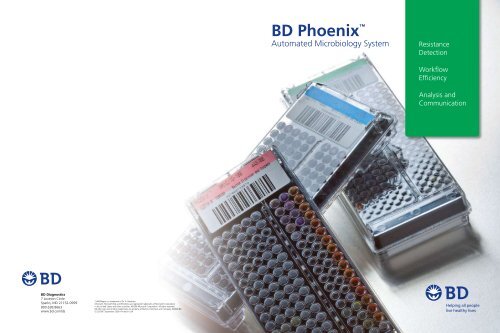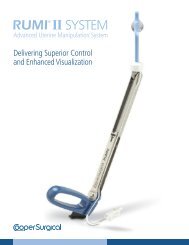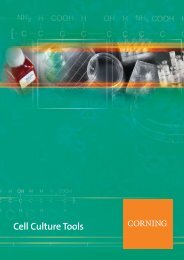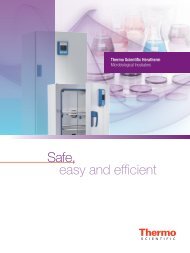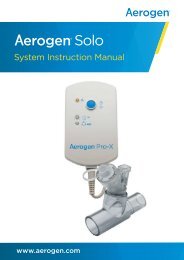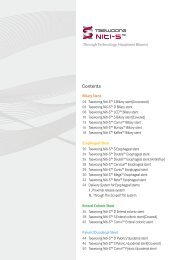You also want an ePaper? Increase the reach of your titles
YUMPU automatically turns print PDFs into web optimized ePapers that Google loves.
<strong>BD</strong> <strong>Phoenix</strong> <br />
Automated Microbiology System<br />
Resistance<br />
Detection<br />
Workflow<br />
Efficiency<br />
Analysis and<br />
Communication<br />
<strong>BD</strong> Diagnostics<br />
7 Loveton Circle<br />
Sparks, MD 21152-0999<br />
800.638.8663<br />
www.bd.com/ds<br />
CHROMagar is a trademark of Dr. A. Rambach.<br />
Microsoft, Microsoft SQL and Windows are registered trademarks of Microsoft Corporation<br />
in the United States and other countries. ©2008 Microsoft Corporation. All rights reserved.<br />
<strong>BD</strong>, <strong>BD</strong> Logo and all other trademarks are property of Becton, Dickinson and Company. ©2008 <strong>BD</strong><br />
0-222786 September 2008 Printed in USA
<strong>BD</strong> <strong>Phoenix</strong><br />
Table of Contents<br />
<strong>BD</strong> <strong>Phoenix</strong> <br />
Performance<br />
Resistance Detection................................1, 3<br />
Emerging Resistance................................4<br />
<strong>BD</strong> <strong>Phoenix</strong> <br />
AP<br />
Workflow Efficiency.................................5, 6<br />
<strong>BD</strong> EpiCenter <br />
Monitor...Analyze...and Communicate.....7<br />
Expert Systems........................................8<br />
Epidemiology...........................................9<br />
Communication.......................................9
...rapid, accurate and<br />
reliable antimicrobial<br />
susceptibility results...<br />
Resistance Detection<br />
<strong>BD</strong> <strong>Phoenix</strong><br />
Detecting Resistance<br />
Today and in the Future<br />
The <strong>BD</strong> <strong>Phoenix</strong> Susceptibility System<br />
incorporates the use of an oxidationreduction<br />
indicator, turbidometric<br />
growth detection, full on-panel antimicrobial<br />
concentrations and the<br />
<strong>BD</strong>Xpert <br />
System. Together these make<br />
up the <strong>Phoenix</strong> Susceptibility System<br />
resulting in rapid, accurate and reliable<br />
antimicrobial susceptibility results. These<br />
results are further enhanced by specific<br />
delayed resistance features, providing<br />
additional assurance that <strong>Phoenix</strong> results<br />
are not only rapid but accurate.<br />
The inclusion of all reported antimicrobial<br />
concentrations on the panel provides the<br />
foundation for detection of emerging<br />
resistance. Simply stated, the <strong>Phoenix</strong><br />
Susceptibility System was designed to<br />
detect antimicrobial resistance today<br />
and in the future.<br />
1 • <strong>BD</strong> <strong>Phoenix</strong>
Resistance<br />
DETECTION
Confirmation is the key feature of the <strong>BD</strong><br />
<strong>Phoenix</strong> ESBL Resistance Marker Detection.<br />
• Confirmatory extended spectrum<br />
beta-lactamase (ESBL) testing for<br />
Escherichia coli, Klebsiella pneumoniae<br />
and Klebsiella oxytoca<br />
• Definitive beta-lactamase detection<br />
in staphylococci<br />
• Methicillin Resistance<br />
in Staphylococcus aureus<br />
• Predictive mecA detection utilizing<br />
Cefoxitin for Staphylococcus aureus<br />
• Vancomycin resistance in enterococci<br />
• High-level aminoglycoside resistance<br />
in enterococci<br />
• Vancomycin resistance in<br />
Staphylococcus aureus<br />
All resistance marker testing is<br />
included on every panel of the<br />
appropriate type so there is<br />
no need for additional tests or<br />
added incubation. This results<br />
in faster reporting and less<br />
additional or repeat testing.<br />
3 • <strong>BD</strong> <strong>Phoenix</strong>
Emerging Resistance Detection<br />
In addition to accurately confirming known<br />
resistance, the <strong>Phoenix</strong> Susceptibility System<br />
is an industry leader in rapidly detecting<br />
resistance in organisms to antimicrobials<br />
that historically have been susceptible. This<br />
rapid detection allows for appropriate patient<br />
therapeutic intervention.<br />
The combination of the <strong>Phoenix</strong> Susceptibility<br />
System and extensive resistance marker<br />
detection provides rapid results from<br />
instrument 25 to report without delays.<br />
20<br />
15<br />
10<br />
Emerging<br />
RESISTANCE<br />
5<br />
Beta-Lactam Susceptibility and Pseudomonas aeruginosa<br />
Juretschko, et. al., JCM Vol 45, No 4, Apr 2007<br />
VME %<br />
25<br />
20<br />
15<br />
10<br />
5<br />
0<br />
AZT FEP CAZ IMP PIP TZP<br />
<strong>Phoenix</strong> Vitek Vitek 2 MS<br />
<strong>Phoenix</strong> VME rate less than 2%<br />
across tested antimicrobials.<br />
0<br />
AZT FEP CAZ IMP PIP TZP<br />
<strong>Phoenix</strong> Vitek Vitek 2 MS<br />
Detection of Carbapenem Resistence in Klebsiella pneumoniae – Meropenem<br />
Tenover, et. al. Emerging Inf. Dis. Vol 12 No 8, Aug 06<br />
Number of Organisms<br />
14<br />
14<br />
12<br />
12<br />
10<br />
1014<br />
8<br />
812<br />
6<br />
610<br />
4<br />
4 8<br />
2<br />
2 6<br />
0<br />
0 4<br />
2<br />
Detection of Carbapenem Resistence in Klebsiella pneumoniae – Imipenem<br />
0<br />
14<br />
14<br />
12<br />
12<br />
10<br />
1014<br />
8<br />
812<br />
6<br />
610<br />
4<br />
4 8<br />
2<br />
2 6<br />
0<br />
0 4<br />
Tenover, et. al. Emerging Inf. Dis. Vol 12 No 8, Aug 06<br />
Number of Organisms<br />
2<br />
0<br />
<strong>Phoenix</strong> Vitek 2 MS Sensititre<br />
<strong>Phoenix</strong> Vitek 2 MS Sensititre<br />
<strong>Phoenix</strong> Vitek 2 MS Sensititre<br />
<strong>Phoenix</strong> Vitek 2 MS Sensititre<br />
<strong>Phoenix</strong> Vitek 2 MS Sensititre<br />
<strong>Phoenix</strong> Vitek 2 MS Sensititre<br />
S<br />
S<br />
I<br />
I<br />
R<br />
R<br />
S<br />
S<br />
I<br />
I<br />
R<br />
R<br />
S<br />
I<br />
R<br />
S<br />
I<br />
R<br />
<strong>Phoenix</strong> performance in<br />
detecting Carbapenem<br />
resistance.<br />
<strong>BD</strong> <strong>Phoenix</strong> • 4
<strong>BD</strong> <strong>Phoenix</strong> AP<br />
• Decreases technologist time<br />
and labor to prepare panel<br />
• Standardizes inoculum in laboratory<br />
• Incorporates state-of-the-art<br />
automated nephelometry<br />
<strong>BD</strong> <strong>Phoenix</strong> <br />
AP Workflow Efficiency<br />
With the availability of the <strong>BD</strong> <strong>Phoenix</strong> AP, the <strong>Phoenix</strong><br />
System incorporates state-of-the-art technology, providing<br />
the laboratory workflow efficiency and standardized isolate<br />
inoculum. The <strong>BD</strong> <strong>Phoenix</strong> AP is the first system to<br />
incorporate automated nephelometry in ID/AST testing.<br />
This step has traditionally been the most time consuming,<br />
manual step associated with isolate preparation.<br />
To inoculate a panel using <strong>Phoenix</strong> AP, laboratory technologists<br />
simply make a ‘heavy’ suspension of the<br />
isolate to be tested in <strong>Phoenix</strong> ID broth. The <strong>Phoenix</strong><br />
AP is capable of processing a starting McFarland of<br />
0.20 to 4.0 to the appropriate testing McFarland. The<br />
ID broth and corresponding AST broth are placed in<br />
a <strong>Phoenix</strong> AP rack and loaded onto the system<br />
for preparation.<br />
that may include patient name, patient location,<br />
sample accession number, specimen type, <strong>Phoenix</strong><br />
panel type, and isolate number. Utilizing the EpiCenter<br />
barcode eliminates the need for additional keystrokes<br />
by the technologist, further streamlining the panel<br />
loading process.<br />
Starting – Ending McFarland Per Isolate<br />
The estimated rack processing time is 5-7 minutes.<br />
Each <strong>Phoenix</strong> AP is capable of processing 200 ID/AST<br />
sets in less than 4.5 hours.<br />
The <strong>Phoenix</strong> AP incorporates the <strong>BD</strong> EpiCenter <br />
Barcode<br />
Printing Software into the workflow. Each ID broth may<br />
be identified with an EpiCenter generated barcode label<br />
5 • <strong>BD</strong> <strong>Phoenix</strong> AP
<strong>BD</strong> <strong>Phoenix</strong> <br />
AP Workflow – Prep and Pour<br />
1<br />
Prepare Inoculum<br />
• Label ID tube with EpiCenter <br />
or LIS barcode<br />
3<br />
Remove Processed Tubes and Place on<br />
Inoculation Station with <strong>Phoenix</strong> Panels<br />
• Single or batch inoculation<br />
• Select colonies and make a<br />
heavy suspension in ID broth<br />
• Central or individual work stations<br />
• Place in rack with AST broth<br />
4<br />
Scan Barcodes into <strong>BD</strong> EpiCenter <br />
and Inoculate Panels<br />
2<br />
<strong>BD</strong> <strong>Phoenix</strong> AP<br />
• Provides rapid, efficient batch sample login<br />
• Performs automatic nephelometry<br />
to 0.5 or 0.25 McFarland<br />
• Adds AST indicator to AST broth<br />
• Transfers isolate to AST broth<br />
• Mixes both samples<br />
5<br />
• Supports single-handed barcode scanning<br />
• Provides positive sample ID for <strong>Phoenix</strong> isolate<br />
Open <strong>BD</strong> <strong>Phoenix</strong> Door and Place Panel<br />
in Any available station<br />
<strong>Phoenix</strong> AP<br />
2<br />
3<br />
1<br />
4<br />
5<br />
<strong>BD</strong> <strong>Phoenix</strong> AP<br />
<strong>BD</strong> <strong>Phoenix</strong> AP • 6
<strong>BD</strong> EpiCenter<br />
<strong>BD</strong> EpiCenter <br />
System<br />
Monitor….Analyze….and Communicate<br />
Monitoring, analyzing and communicating microbiology data in<br />
a timely manner can directly impact patient care and should be<br />
the goal of every facility. Obtaining, organizing and communicating<br />
this information is labor intensive and current information systems<br />
can make even routine antibiogram generation difficult. Today<br />
microbiologists, infection control officers, physicians and pharmacists<br />
need immediate access to patient focused information to rapidly<br />
identify and react to emerging resistance or HAI events. EpiCenter<br />
provides the real-time data access and analysis tools these professionals<br />
can use to improve patient care.<br />
7 • <strong>BD</strong> EpiCenter
Expert Systems<br />
ID/AST Result Consistency<br />
Quality Assurance Policy Compliance<br />
The <strong>BD</strong> <strong>Phoenix</strong> <br />
Automated Microbiology System,<br />
when connected to EpiCenter, employs an enhanced<br />
<strong>BD</strong>Xpert system that presents expertised results to<br />
technologists. The <strong>BD</strong>Xpert system represents a “best<br />
practice” microbiology system as it incorporates Clinical<br />
and Laboratory Standards Institute standards in the<br />
analysis of ID/AST results.<br />
To complement the <strong>BD</strong>Xpert system, the optional<br />
EpiCenter Clinical Application Rule Editor, <strong>BD</strong> EpiCARE ,<br />
is available to EpiCenter users. The EpiCARE software<br />
provides managers in microbiology and other<br />
departments the ability to define specific rules and<br />
actions to ensure policy compliance for the reporting<br />
of microbiology data.<br />
The software allows users to define rules based on<br />
any patient or facility demographic coupled with<br />
an ID/AST result outcome. Managers can utilize<br />
the proactive alerting capability integrated into the<br />
EpiCenter software to ensure that the proper action<br />
is taken when each event is identified. Using EpiCenter,<br />
an Infection Control Officer is able to ensure that the<br />
correct individuals are notified when an HAI event<br />
occurs and/or what specific organisms or resistance<br />
patterns are detected.<br />
Rule<br />
1<br />
Generates the message for the system message<br />
EpiCenter<br />
Rule<br />
2<br />
Generates the message for the e-mail to blackberry<br />
<strong>BD</strong> EpiCenter • 8
Epidemiology<br />
Performing time-sensitive epidemiology studies as<br />
well as quality and workload management analysis is<br />
simplified and intuitive using the software’s powerful<br />
data mining tools, graphical interface and Microsoft XP <br />
and SQL Server <br />
architecture. Compiling, analyzing and<br />
communicating information has never been easier<br />
because the software is easily networked so that<br />
everyone can have secure access to this time-sensitive<br />
patient data.<br />
The EpiCenter library is enhanced with over one hundred<br />
predefined queries and reports. This extensive library<br />
provides the ability to quickly access data, analyze it<br />
in multiple formats, and share your findings with others.<br />
Integrated into the software are simple-to-use tools<br />
to customize the predefined reports and save them as<br />
personal favorites.<br />
Communication<br />
Using <strong>BD</strong> EpiCenter Multi-User <br />
software opens up avenues for improved<br />
laboratory productivity and communication between the laboratory and<br />
other departments. The laboratory can add workstations to improve<br />
workflow between different areas within the lab. In addition, physicians,<br />
infection control professionals and pharmacists can gain real-time access<br />
to information and EpiCenter data analysis tools from the convenience<br />
of their own computers. Whether it is monitoring organism phenotypic<br />
trends to resistance marker alerts and organism surveillance, <strong>BD</strong> EpiCenter<br />
provides real-time information to those clinicians that can affect patient care.<br />
Adding the <strong>BD</strong> Sentinel option to the <strong>BD</strong> EpiCenter System improves communication<br />
capabilities within the Multi-User network. The System Message Distribution feature allows messages<br />
to be directed to specific user clients or to multiple EpiCenter workstations. In addition, Sentinel<br />
messages can be distributed by e-mail to a computer, PDA or text message phone.<br />
9 • <strong>BD</strong> EpiCenter
EpiCenter
<strong>BD</strong> EpiCenter<br />
Data management for <strong>BD</strong> Diagnostics<br />
instrumentation and manual testing.<br />
Communication of data within the<br />
lab and beyond.


